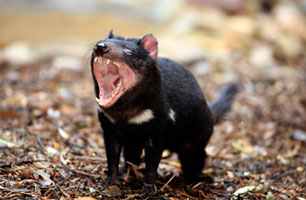
Getty Images
Whether on television or in the real world, it seems like the Tasmanian devil just can’t catch a break. In Robert McKimson’s Looney Tunes of the 1950s, the devil “Taz” was little more than a dim-witted glutton; in the Australian forest, the animal has been tethered to the endangered species list for over a decade by a deadly cancer called devil facial tumor disease (DFTD). But new research on devil genomes may put a stop to the devils’ never-ending bad luck: scientists are using genome sequencing to engineer captive breeding programs, which will hopefully create hardier devils more resistant to the infectious DFTD—and finally provide that elusive plan of action to save the ferocious marsupials.
DFTD has been the main catalyst in the freefall decline of the devils since 1996, with road-kills, predators, and persecution being the other culprits. First observed in a far northeastern corner of Tasmania, DFTD inflicts hideous facial lesions upon unfortunate devils and ultimately causes death from starvation or suffocation. But the worst thing is that DFTD is contagious: devils pass it to one another through biting, and 89% of the island’s devils have fallen prey to the disease since it was first reported. As research leader Stephan Schuster told Physorg.com:
This malignant cell is transferred directly from one individual to another through biting, mating, or even touching. Just imagine a human cancer that spread through a handshake—and what that would do to our species.
(More from TIME: Decoding the Tasmanian Devil’s Deadly Cancer)
So the researchers had a pretty big job to do, and they used two Tasmanian devils, named Cedric and Spirit, to do it. The two devils hailed from the extreme northwest and southeast regions of Tasmania respectively, allowing for the widest possible geographic spread of the species – a measure analogous to genetic diversity – in the study. Cedric survived several strains of DFTD, but eventually succumbed; Spirit was nearly dead from the disease when the scientists found her. By sequencing the genomes of both animals, and of one of the tumors ravaging Spirit’s body, the researchers created a model that will help determine which individual devils should kept in captivity. Keeping the right devils in captivity will hopefully increase the genetic diversity of the animals, and consequently their chances of surviving the deadly DFTD. As the authors wrote:
The inability to mount an immune response and to reject these tumors might be caused by a lack of genetic diversity within a dwindling population.
If that’s the case, then the devils were in a rough position to begin with: a 2007 study by Kathy Belov confirmed that Tasmanian devils lack genetic diversity, and so their immune systems simply don’t treat tumor cells as a threat. So choosing the right individuals to represent the widest genetic variation possible is crucial, according to Schuster:
It might seem you’d want to choose only those individuals that are genetically resistant to the DFTD cancer. However, that would defeat the purpose of maintaining genetic diversity because, by definition, you’d be selecting a tiny subset of the gene pool. Instead, our model suggests a more balanced approach. You don’t want to put out just the one fire – the cancer. Instead, you want to develop a pool of diverse, healthy individuals that can fight future maladies or even pathogens that have not yet evolved.
But DFTD isn’t entirely to blame for every misfortune that has befallen the Tasmanian devil: the animal’s notable lack of genetic diversity, for example, has been virtually the same since Europeans colonized Tasmania two centuries ago. The authors dug deep into the Smithsonian in Washington, D.C. and London’s Natural History Museum to find hair shaft samples from Cedric and Spirits ancestors, which they sequenced and compared to the genomes from the younger devils – and it turns low genetic diversity in Tasmanian devils is much older than 15-year-old DFTD. Such constancy in genetic diversity may mean the species will survive, the authors wrote, “assuming adequate habitat areas and population numbers and that current diversity can be maintained with the help of a captive breeding program.”
(More from TIME: Protecting Biodiversity Might Just Protect Us from Disease)
Though the team’s findings look promising, time is running out for Tasmanian devils – scientists predict the creatures could be extinct in the wild within 20 years, and it remains to be seen whether captive breeding can offset the damage wrought by an aggressive and contagious disease that has not yet seen a cure. There was hope for a vaccine in 2010, but we all know cancer – human or marsupial – is a difficult beast to tackle, and the jury’s still out on whether that vaccine will materialize. Hopefully Schuster and his team will help ensure that Taz from Looney Tunes won’t be the only devil we have left in a couple of years.
(Video from TIME: Saving the Tasmanian Devil)


